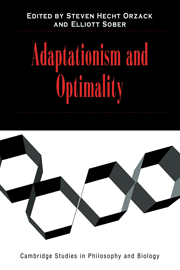Book contents
- Frontmatter
- Contents
- Contributors
- Acknowledgments
- Introduction
- 1 A Likelihood Framework for the Phylogenetic Analysis of Adaptation
- 2 Adaptation, Phylogenetic Inertia, and the Method of Controlled Comparisons
- 3 Optimality and Phylogeny: A Critique of Current Thought
- 4 Fit of Form and Function, Diversity of Life, and Procession of Life as an Evolutionary Game
- 5 Optimality and Evolutionary Stability under Short-Term and Long-Term Selection
- 6 Selective Regime and Fig Wasp Sex Ratios: Toward Sorting Rigor from Pseudo-Rigor in Tests of Adaptation
- 7 Is Optimality Over the Hill? The Fitness Landscapes of Idealized Organisms
- 8 Adaptation, Optimality, and the Meaning of Phenotypic Variation in Natural Populations
- 9 Adaptationism, Optimality Models, and Tests of Adaptive Scenarios
- 10 Adaptation and Development: On the Lack of Common Ground
- 11 Three Kinds of Adaptationism
- 12 Adaptation, Adaptationism, and Optimality
- Index
4 - Fit of Form and Function, Diversity of Life, and Procession of Life as an Evolutionary Game
Published online by Cambridge University Press: 06 January 2010
- Frontmatter
- Contents
- Contributors
- Acknowledgments
- Introduction
- 1 A Likelihood Framework for the Phylogenetic Analysis of Adaptation
- 2 Adaptation, Phylogenetic Inertia, and the Method of Controlled Comparisons
- 3 Optimality and Phylogeny: A Critique of Current Thought
- 4 Fit of Form and Function, Diversity of Life, and Procession of Life as an Evolutionary Game
- 5 Optimality and Evolutionary Stability under Short-Term and Long-Term Selection
- 6 Selective Regime and Fig Wasp Sex Ratios: Toward Sorting Rigor from Pseudo-Rigor in Tests of Adaptation
- 7 Is Optimality Over the Hill? The Fitness Landscapes of Idealized Organisms
- 8 Adaptation, Optimality, and the Meaning of Phenotypic Variation in Natural Populations
- 9 Adaptationism, Optimality Models, and Tests of Adaptive Scenarios
- 10 Adaptation and Development: On the Lack of Common Ground
- 11 Three Kinds of Adaptationism
- 12 Adaptation, Adaptationism, and Optimality
- Index
Summary
Three questions have captivated naturalists for millennia:
The Fit of Form and Function: How is it that organisms have behaviors, physiologies, and morphologies that make them remarkably suited to their environments and lifestyles?
The Diversity of Life: Why are there so many species and varieties of organisms?
The Procession of Life: How is it that life seems organized from simple to complex along only a handful of common design features?
Evolution by natural selection offers explanations and answers to these questions, and evolutionary game theory offers a framework for modeling and conceptualizing natural selection. In the past 25 years, evolutionary game theory has developed from a shortcut method for solving problems in pair-wise behavioral interactions to an approach for investigating the consequences of natural selection (Weibull 1995; Hofbauer and Sigmund 1998).
Evolutionary thinking has arrived at some exciting junctures. Malthus's principle of limits to growth and Darwin's principle of heritable variation influencing these limits are two foundational principles of ecology and evolution (Orians 1962; Sober 1984, 1993; Bell 1997). Yet natural selection often disappears or plays a minor role in current ideas on biological diversity, speciation, and the history of life. In this way, ecological and evolutionary theories of biodiversity often lack conceptual unity or cohesion. Speciation is seen as a separate process from natural selection. Natural selection as the driver of speciation occurs in the literature (Thoday and Gibson 1962; Maynard Smith 1966; Rosenzweig 1978; Schluter and Nagel 1995; Funk 1998), yet it remains “unsubstantiated” (Rice and Hostert 1993) in the minds of many observers and is all but absent from the pages of textbooks.
- Type
- Chapter
- Information
- Adaptationism and Optimality , pp. 114 - 160Publisher: Cambridge University PressPrint publication year: 2001
- 7
- Cited by



